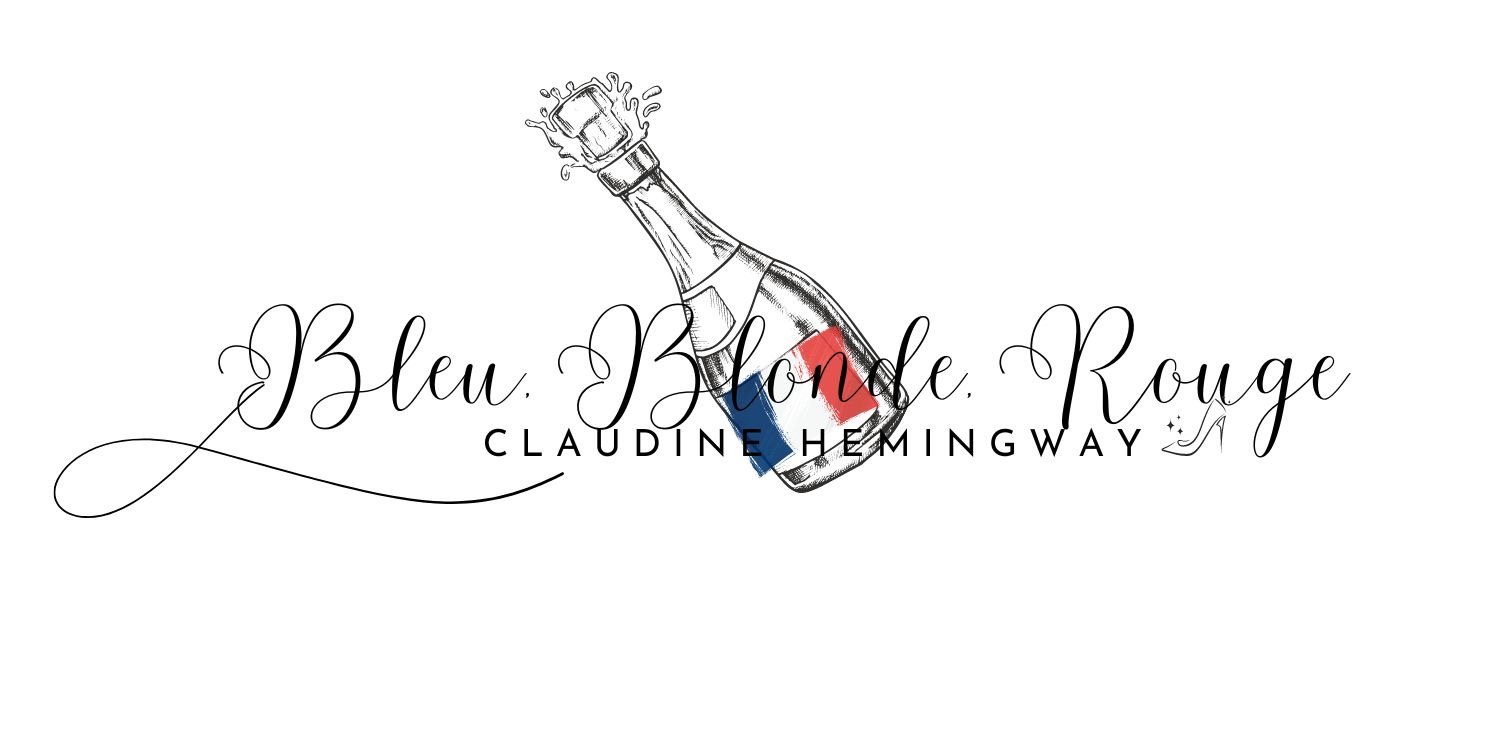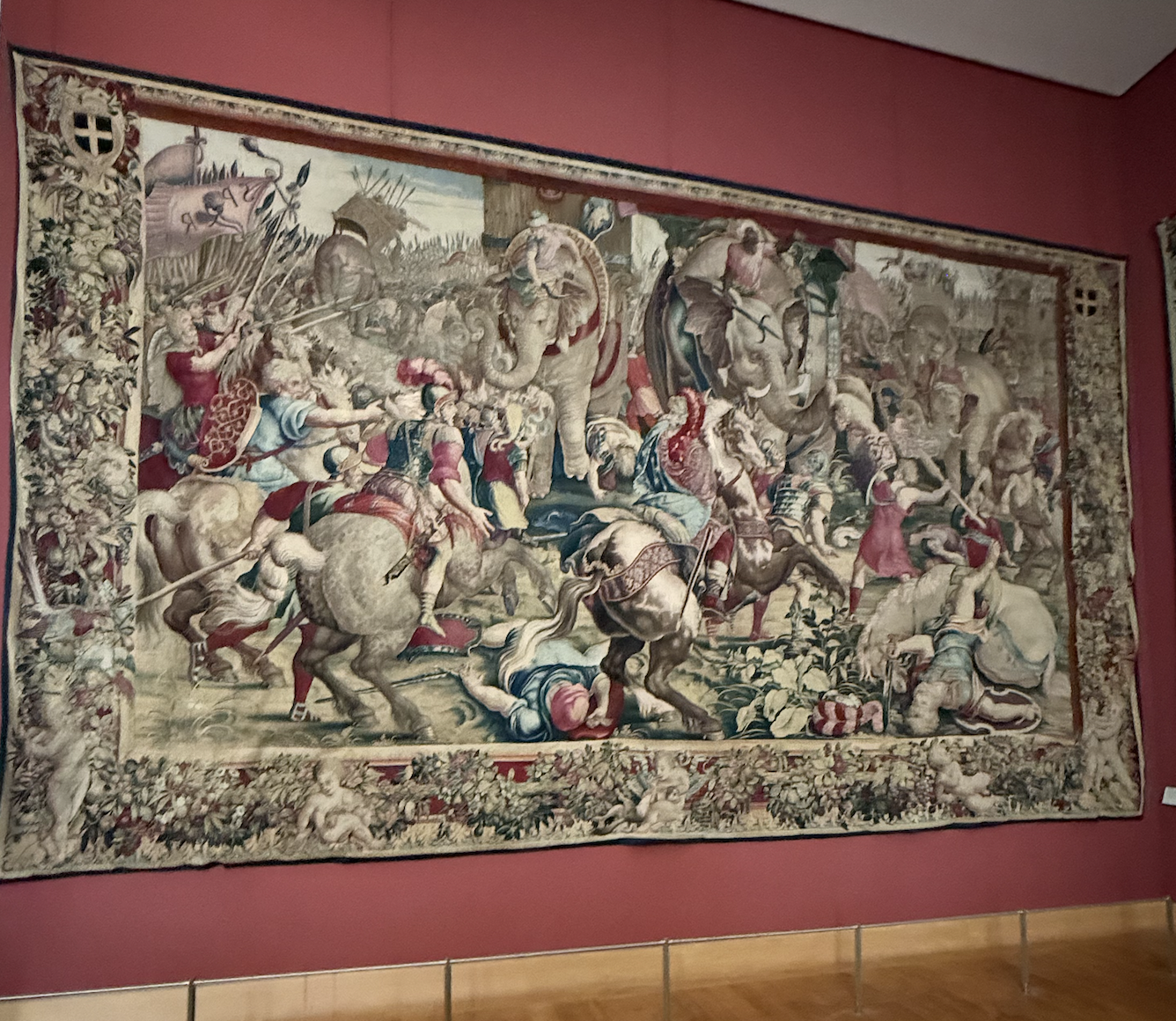Keeping on through the wonderfully air-conditioned rooms of the Richelieu wing of the Louvre, we find another tapestry-lined room. The set created for Louis XIV dates back much farther, to the king who rewrote the rules of the monarchy, François I. We owe the Renaissance and the love of all the artistic things in France to him. His mother, Louise de Savoie, raised François and his sister, Marguerite, with a heavy mix of art, literature, and all things Italian Renaissance. Francois became king of France at 20 years old, his mother was just eighteen years old, and a close adviser. It is François who had the Louvre we know today and also filled it with art.
The great chateaux of the Loire Valley built under the reign of François I were cold and drafty in the winter. The large-scale tapestries helped to fend off the cool drafts and also add a bit of flash to the stone walls. In 1532, François commissioned a set of twenty-four tapestries made in gold, silver, and silk chronicling the “deeds and triumphs” of Scipion d’Africain from the atelier of Guillaume Dermoyens in Belgium. The most extensive collection of woven, which once hung in the Chateau de Chambord. During the Revolution in 1797, the tapestries were burned to melt down the gold and silver threads.
Henri II, son of François I, in 1577 also commissioned a reduced set of ten for Jacques d’Albon, Marshall of France, complete with his coat of arms in the upper corners. Later purchased by Cardinal Mazarin in the 17th century, and then into the hands of Louis XIV. This set was sold during the Revolution, and four have found their way to the Hearst Castle in San Simeon, California.
Under Louis XIV, the superintendent of buildings, arts, and manufactures. The Marquise de Louvois ordered numerous tapestries from the Garde-Meuble. While the Garde-Meuble was experiencing financial difficulties and an effort to keep the weavers busy, Louvois decided to order copies of 16th-century tapestries instead of commissioning artists to design new ones. Eight of the ten tapestries, dating back to 1688, can be found here in the Louvre; the other two are still at the Gobelins.
With Louis XIV's penchant and adoration of significant mythological and military figures, Louvois knew he would hit a home run with the selection of the Scipio tapestries. Publius Cornelius Scipio Africanus was born around 236 BC in Rome. His father, Publius Cornelius, was a Roman general who took his young son with him into battle. In 218 BC, at the Combat du Tessin in Northern Italy, he witnesses his father and uncle become badly injured and saves them.
The episode is captured in the first tapestry on the west wall. Tessin, today’s Turin, which you can see in the background of the tapestry. Controlled by the Carthaginian general Hannibal Barca, Scipio’s Roman army of javelin throwers was no match. Hannibal’s army, with the help of the Numidian horsemen, attacks and kills many of the Roman soldiers. In the lower center of the tapestry, Scipio senior is depicted falling from his horse with a large gash in his head.
Combat du Tessin
To the right of the tapestry is the carton version of the same scene by Fermo Ghisoni. Tapestries are often created from a carton version of the image, painted with tempera on sheets of paper that are then glued together and laminated. Look closely and you can see the sheets on the carton. The image needed to be malleable so that the weaver could then copy it onto the warp threads on the loom before weaving began. The warp is the vertical threads that are pulled with tension in the loom, serving as the design of the image and becoming invisible in the process. The weft is the horizontal threads that create the actual scene of the tapestry. Neutral colors are often found in wool, while bright colors are typically used in silk, which tends to lose its color over time, contributing to the muted appearance of many tapestries today.
Episode two hangs on the south wall to the left of the Combat. The Capture of Carthage on the Iberian Peninsula was a triumphant moment for Scipio. Using his army of more than 28,000 men, 34 boats, and 3,000 horses, he attacked Hannibal and his army before they could react. The army stretches on for miles throughout the image, with Scipio in the lower right corner urging his army to fight. The tapestry shows the dominance he had over Hannibal’s army, marking one of the defining moments of his career.
The Capture of Carthage
The third tapestry depicts one of the most famous episodes of Scipio’s life and can also be found on the ceiling of the Louvre. La Continence de Scipion takes place around 209 BC after his control of New Carthage. On the left, a Roman soldier presents a young lady they have captured, who was betrothed to a Spanish prince. A Roman soldier has come to Scipio, who sits on a throne, and presents a basket of precious items in the hope of being able to pay for her release. Scipio, in turn, orders her release and calls off the marriage, tells the father to keep the items for her future dowry as long as he pledges his allegiance to Rome. The scene is also painted on the ceiling of the Grand Cabinet of the Queen in the summer apartments of Anne of Austria in the Denon wing.
La Continence de Scipion
La Continence de Scipion in the Anne of Austria summer apartments
The next hanging is another carton, and it is the only version of the story we have in the Louvre. In the scene of 204 BC, after Scipio had conquered Spain, he sought to establish an alliance with neighboring countries to consolidate his dominance in the region; however, he also attempted to gather intelligence and information on his enemy at the same time. Invited by Numidian king Syphax, who was already an ally of Carthage. Depicted in the image on the right is Syphax sitting on a throne, and Scipio is just to his right. Across the table is Hasdrubal Gisco, who looks on quite confused.
In the background, the mantle is covered with gold and silver vases and urns while the staff work quickly to serve the lavish meal of the palace. Scipio was able to win Syphax over to Rome's side. Shortly after, he sets fire to his camp, which we will see in another tapestry. The size of the carton is reduced from the actual tapestry, which is in the collection of the Garde-Meuble.
We skip to episode six with L’Arrivée en Afrique in 204 BC. Scipio was named consul in 205 BC, and Africa was next on his horizon. Arriving first in Sicily, he gathered more than 30,000 troops and 450 boats and warships. Between late summer and early fall, Scipio and his army arrived in Utica on the northern tip of what is now Tunisia. Scipio is seen on the right, wearing smashing red leggings and wrapped in a blue cloak with stars pointing towards the shore. The chaotic scene on the boat gives it movement, and the waves below splash against the boat's relief of Roman gods. In 202 BC, Scipio finally defeated the Carthaginians.
L’Arrivée en Afrique
The next tapestry, L’incendie du Camp, captures a day that some historians say may have been a bit exaggerated. After the dinner at Syphax’s palace, Scipio gathered intel that he would later use to his advantage. Deciding to set fire to his camp, he caused massive confusion, and the Roman tactician used it to attack his enemy. Scipio is seen on the right upon his horse as he rushes into the confusion. In the upper right, you can see the elephants of the Carthaginian army, which we will examine more closely in the final tapestry.
L’incendie du Camp,
The decisive moment in the story of Scipio comes in the last tapestry, the Battle of Zama. Taking place on October 19, 202 BC, in Zama Regia, near Siliana, Tunisia. The army of Massinissa (Algeria) joined forces with Scipio’s massive army and took on Hannibal Barca and his army, led by eighty war elephants. These specially trained elephants accompanied Hannibal everywhere, including over the Alps to Italy. Each topped with a howdah, the box-like saddle wth high sides held soldiers armed with bow and arrows and javelins. The first line of defense, the enormous elephants, were quickly startled by the Roman horns and began to retreat in chaos.
Hannibal was no match and was defeated, ending the 18-year war. Scipio was awarded the name Africanus for his heroic role in ending the war in Carthaginian Africa. He would go down in history as one of the most outstanding leaders, inspiring everyone from Julius Caesar to Napoleon Bonaparte, as well as François I and Louis XIV, who had copies of these tapestries created.
Battle of Zama
Flowers are the theme of the other two designs in this room. In a dusty mauve pink Alexandre McQueen suit. Appearing on October 6, 2006, at the Cirque d’Hiver in Paris under a lone crystal chandelier covered in spiderwebs and tuile. The Spring/Summer 2007 collection of McQueen’s label was named Sarabande after a popular Spanish dance that swept through France at the beginning of the 17th century. Even Cardinal Richelieu was known to dance at the Louvre.
The twenty-ninth collection of McQueen was inspired in part by the 1975 Stanley Kubrick movie, Barry Lyndon. Taking place in mid-18th-century British society, Ryan O’Neil recreates the period's costuming, which comes to life on the runway with a touch of Spanish influence. Romantic, poetic, theatrical, and decaying are all words used to describe the collection. The look we see in the Louvre was the second-to-last of forty-six looks.
In dusty pink silk moiré and tuille, a very structured jacket features a wide-open boat neck and bell sleeves, paired with a skirt that evokes an abbreviated pannier side hip cage, reminiscent of days gone by. McQueen filled the neck, sleeves, and inside the pannier with fake flowers that overflowed, much like the tapestries that filled the room.
Although I have strong feelings about faux flowers, the final piece included both real and fake flowers that fell as the model walked, creating a floral trail. Set in the center of the Cirque d’Hiver, which Toulouse Lautrec loved to visit and sketch, the reclaimed wood stage harkened back to a Shakespearean in-the-round stage. An orchestra sat under the chandelier playing Handel’s Sarabande, complete with harpsichord, as the models passed through the center.
McQueen created seven more collections until his tragic end. On February 11, 2010, he took his own life just days after his mother passed away. His final collection was only 80% complete at the time of his death and was due to hit the runway a month later. On May 8, at a closed and private showing, his final 16-piece collection was unveiled to a select audience.
His longtime friend and muse, Sarah Burton, took over the house after his death and led it until 2023, when she moved to Givenchy. McQueen had also served as the creative director of the French label from 1997 to 2001, before leaving to focus solely on his label. Today, the McQueen label continues under the leadership of Irishman Séan McGirr, part of the Kering, Gucci family of labels.
Check out the video of the 2007 Haute Couture collection here.













